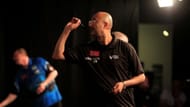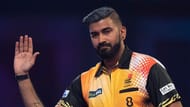Darts is one of the fastest-growing sports in the world. India is one of the fastest-growing nations in the world. Yet, there is a lot of work to be done if India are to mainstream the sport of darts.
The widespread selling of dartboards would be a start, but in some areas that doesn't seem to be a problem. With the modernisation of the nation has come the chance for all areas to become darts hot spots, which inevitably produces odd players with talent despite the nation's lack of interest in general.
But why should that change? Darts is a simple game and takes little to learn the rules. The skill is easy to learn but immense once mastered and the accuracy involved in this sport is matched by no other.
The maths involved makes any regular darts player look like a mathematical genius to others once combinations are learned via repetition on how to finish certain numbers. A player starts from 501 points and goes down by hitting numbers to 0, having to finish on a double.
Ask any darts player how to finish 131 and they will tell you treble 20, treble 13 and double 16, which might confuse you, but once you start to play the game such things become simple to pluck out of the air.
Some other Asian nations, such as Japan and the Philippines have taken to darts like a duck to water, now producing top-class talents like Seigo Asada and new two-time back to back women's world champion Mikuru Suzuki from Japan and Lourence Ilagan and Noel Malicdem from the Philippines.
So when darts is so big in the continent now with marketing and new opportunities sent their way by the biggest organisation, why hasn't India leapt into the world of darts? Let's take a look at why India should grow darts nationwide, which players in India are currently have made an impact, how India's new tournament called the 'Darts Premier League' figures into the equation and where to go next.
#4 It's fun and quick to understand

Darts is a sport worth investing in for the future because it's fun, and once darts takes off in a nation, it takes off. Ask Germany, who are the prime example of darts mania gone crazy, and now the nation is host to many major darts tournaments, including European Tour, the World Cup and the European Championship finals, having previously hosted Premier League nights in the past.
The nation now have darts second only in sports popularity to football, a phenomenon matched by the Netherlands, and the fever has spread to neighbours Austria, who will host the World Series of Darts Finals, hoping their local hero and darts superstar Mensur Suljovic will reign supreme come the end.
If India pick up the sport, there is no reason why the World Series of Darts can't deviate from the USA, Japan, Australia, New Zealand, Scandanavia and Germany to visit India.
There are no barriers. Darts isn't a sport affected that any characteristic and anyone can pick it up very quickly. A common phrase is 'darts is an easy sport to play, but a hard sport to play well', so it's easy to start and get competitive, but only the dedicated and mentally strong can succeed at the best level and are rewarded for the work put in. It is unlikely large numbers of people in India will be immediately naturally talented given the nation's inexperience with the sport historically.
There's lots of interest and money in modern-day darts. Every continent has bought into the sport and opportunities are growing for any country which wants it. Brazil now have a top player with Brazil's Diogo Portela and Africa have a tour card holder in South Africa's Devon Petersen, so even in the most obscure darts nations, superstars can emerge; and it only takes one to send the nation darts crazy and into the World Cup.
South Africa and Brazil took their spots in the 32-nation affair and Portugal look to become the next smaller darts nation to take their place after Jose de Sousa set the darting world alight in non-televised tournaments last year having claimed his tour card.
#3 Lack of competitors at the global stage

In terms of which Indian darts players are most likely to break through, it's not looking as pretty as it could right now, especially considering the huge population.
Prakash Jiwa was India's first real darting pioneer, but the issue of lack of matches in India saw him move to the UK to get his game sharper in view of winning and keeping a professional tour card, which means you can play year-round on the professional circuit for two years. He has achieved this on two occasions, earning time as a professional from 2015-2017 and again in 2017-2019.
He has taken part in the UK Open many times and notable results in the Player's Championship non-televised events include a narrow loss to current world no.1 Michael van Gerwen and a 6-4 win over five-time World Champion Raymond van Barneveld, but he never broke the World's Top 64, which is required to keep a professional tour card after two years.
However, it is Nitin Kumar who is currently the undisputed number one in India's darts roster right now. Unfortunately, there are so few darts opportunities in India that Nitin has relocated to Dubai to take part in more top-class darts tournaments. For the last two years, the PDC has set aside a spot in the 96-man World Championships for an Indian qualifier, which Nitin has won both years so far.
The first year he drew upcoming Dutch prospect Jeffrey de Zwaan, going down 3-0 in sets but managed to pick up a few legs along the way. Nitin averaged a poor 77.75 compared to de Zwaan's 91.18, which is around standard for the earlier rounds in the competition.
Nitin will be very pleased with his performance at the 2020 World Championships, as, despite his 3-0 loss to Northern Ireland's Brendan Dolan, he managed to average 90.17 compared to Dolan's 97.35, which was a superb performance from the Northern Ireland veteran. Kumar managed to get four legs along the way and didn't allow Dolan to win any of the three sets 3-0 despite Dolan's ruthless finishing on doubles.
Kumar can do better, however, and is capable of bringing a mid-90s average to big games. He is not currently an owner of one of the 128 professional tour cards, with Kumar having been unsuccessful in his only attempt at Qualification School in 2019, where he failed to break the last 256, which is well short of the last two games required to gain an automatic card and also earns no Q-School Order of Merit points which can also get a player through the mega event.
Amit Gilitwala is a young star from Gujarat. He is a previous winner of the India National Championships and most notably represented India, with Prakash Jiwa, at the 2014 PDC (Professional Darts Corporation) World Cup of Darts.
It wasn't a wonderful performance from the duo, as they went down to Belgium, who had an average 3-dart-score of 91.65 to India's 69.96. Since then, Gilitwala has played on the PDC's youth tour and their second-tier semi-professional tour. Despite most of his biggest achievement coming a while ago, he is only 24 as of 2020, so has years left to improve.
The only other Indian darts player of international note is Ashfaque Sayed, who partnered Nitin Kumar at the 2015 PDC World Cup of Darts, but they were battered 5-0 by Germany in the first round, managing an average of only 67.73 against the hosts, who put in an 81.68 average. Sayed had been active in darts since 2005, but after the 2015 World Cup hasn't really participated in any tournaments of note.
#2 To promote the motive of the Darts Premier League

The Indian Premier League tournament format has been utilised in a brand new darts tournament in India. The Darts Premier League will see nine franchises compete against each other in June this year, with each team endorsed by a celebrity. A prize of ₹10 lakh is on offer and each team will hope a marquee player can help get them to a tournament win in 2020.
However, there are problems with this concept. The IPL and Kabaddi leagues that are so popular with this tournament format are only successful as India are foremost in the respective sports and all the best foreign players are attracted enough to take part.
For this league, the quality will be fairly unimpressive and there are no big names of any kind taking part as overseas stars. Even India's biggest names aren't going to compete as far as we know, with neither Nitin Kumar or Prakash Jiwa in the marquee player list.
The main positive of this league will be attracting new attention to the sport for Indian viewers via the popular franchise format, which will send them in the right direction to see the World Class darts available to watch all year round at the PDC, where stars such as world number one Michael van Gerwen, World Champion Peter Wright and legend Gary Anderson will excite new viewers.
Another positive is the novelty of the league's female participation, as it is mandatory to have three women per team, which emulates and replaces the overseas player rule. Trust me; the spectacle of men going head to head with women at darts isn't something to be missed. Just see Fallon Sherrock at this year's World Championship, where she became the first women ever to win a match at the biggest event in darts.
#1 To boost India's chances of making a mark in another sport

So, what does the future hold for Indian darts? Ultimately, it's up to India to buy into this hobby, because the opportunities are there for new talent and it could be anybody. The biggest temptation for any young Indian darts player must surely be the qualification for the World Darts Championship via the exclusive Indian national qualifier.
With heavy competition for the 96 spots worldwide, this qualifying option may not be available if India doesn't improve the numbers of new darts stars, a reason the country was ultimately pulled from the World Cup. Quality would need to rise if India was to reclaim a spot in that competition via an invitation from the Professional Darts Corporation.
With a huge population of sports hungry youngsters, surely some can reach the heights of a professional tour card? We will see, but the question remains of how long we will wait before we hear 'Game! Shot! And the Match' to an Indian player at the World Championship.
